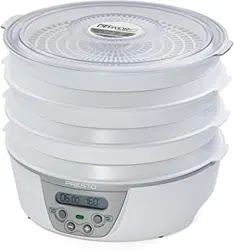Loading ...
Loading ...
Loading ...

4
• For even drying, cut food into uniform sizes, shapes, and thicknesses. Use a Presto
®
SaladShooter
®
slicer/shredder, food processor, or
mandoline to aid in cutting uniform slices.
• Drying times are highly variable depending on the type and amount of food, thickness, evenness of food pieces, humidity, air tem-
perature, personal preference, and even the age of the plant at the time of harvesting. That is why throughout the book you will notice
there is a range of average drying times. In some cases you may find you may need to, or prefer to, dry your foods for shorter or longer
periods than those listed. For best results, begin checking your food at the beginning of the range listed in the instructions. You should
then gauge how often you should recheck the food based on how the drying is progressing. With some foods, such as herbs, that may
mean every 10 minutes, and with other foods, such as fruits, that may mean every 1 to 2 hours.
• Dehydration prevents microbial growth, however, chemical reactions caused by enzymes in fruits and vegetables can occur unless the
product is pretreated before drying. Pretreatment will prevent or minimize undesirable color and texture changes during drying and
storage. See specific sections for recommended pretreatment.
• Place foods in a single layer on the trays. Do not allow food to touch or overlap.
• When drying strong-smelling foods, such as onions and garlic, be aware that there will be a strong odor during the drying process.
That odor may linger after drying has been completed.
• Individual pieces of food may not all dry at the same time. Foods that are appropriately dried should be removed before those that still
require additional drying. Always check all of the trays for foods that are appropriately dried. Allow dried pieces to cool and then
place in a covered container.
• If one tray of food is finished before the others, remove the dried food and return the empty tray to the unit rather than rearranging
the trays.
• Do not add fresh fruits and vegetables to a partially dried load. This will add moisture and increase the drying time.
• Allow for continuous drying. Do not unplug dehydrator in the middle of the drying cycle and resume drying at a later time as this may
result in poor quality and/or unsafe food.
Packaging and Storage
• Dried foods need to be properly packaged to prevent reabsorption of moisture and microbial deterioration. Pack food in clean, dry,
airtight containers. Glass jars or freezer containers with tight-fitting lids are good for storage. Resealable plastic freezer bags are also
acceptable.
• Store packaged dried food in a dry, cool location away from light. Higher temperatures and exposure to light will shorten the storage
time and result in loss of quality and nutrients. Most dried fruit, when properly packaged and stored, will be good for 1 year at 60°F
[15°C] or 6 months at 80°F [26°C]. Fruit leather/rolls should keep for up to 1 month at room temperature. Vegetables have about half
the storage life as fruit. If food is to be kept longer, then store it in a freezer.
• Package vegetables and fruits in separate storage containers to avoid flavor transfer.
How to Dehydrate Fruit and Fruit Rolls
Dried fruits and fruit rolls (or leathers) are nutritious and portable snacks. Drying fruit intensifies the natural sweetness of the fruit
because the moisture is removed.
Fruit
Selection and Preparation
Select fruits that are at the peak of ripeness. Wash fruits to remove dirt and debris. There are many options when it comes to drying fruit
and personal preference should be your guide. Fruits can be sliced, halved, or if small left whole; peeled or unpeeled; pretreated or left
untreated. Fruits that are sliced thin and peeled will dry the fastest. Fruits left whole will require the most drying time. Slice fruit uniformly
and in pieces about ¼ inch thick. Fruits that are left whole, such as blueberries, cranberries, and grapes, should be dipped in boiling water
for 30 to 60 seconds and then plunged in ice water to crack the skin. This procedure will reduce the drying time.
Pretreatment
Many fruits will darken quickly once they are peeled and/or cut and will continue to darken even after the fruit is dried. This is due to the
exposure of the natural enzymes in some fruits to air. There are several pretreatment options to prevent this discoloration. Pretreatment
is not necessary but is recommended to prevent discoloration. Some people may detect a slight flavor change with pretreated fruit. See
the Fruit Drying Guide on page 6 to determine which fruits will benefit from pretreatment. You may want to try the different options
(below and on page 5) to see which you prefer.
Ascorbic acid (Vitamin C)—Ascorbic acid, available in tablet or powdered form, is available at drugstores. Mix 2½ tablespoons
of powdered ascorbic acid in 1 quart cold water. Vitamin C tablets (six 500 mg tablets equal 1 teaspoon ascorbic acid) should be
Loading ...
Loading ...
Loading ...
